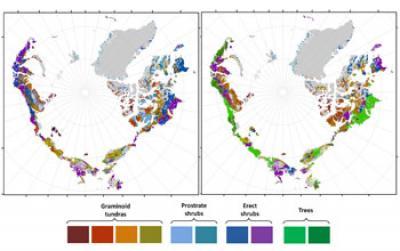Rising temperatures will lead to a "greening" of the Arctic by mid-century, according to a new numerical model.
The greening not only will have effects on plant life, the researchers noted, but also on the wildlife that depends on vegetation for cover. The greening could also have a multiplier effect on warming, as dark vegetation absorbs more solar radiation than ice, which reflects sunlight.
In the paper, scientists detail their new computer projections stating that wooded areas in the Arctic could increase by as much as 50 percent over the coming decades. The researchers also show that this dramatic greening will accelerate climate warming at a rate greater than previously expected.
"Such widespread redistribution of Arctic vegetation would have impacts that reverberate through the global ecosystem," said Richard Pearson, lead author on the paper and a research scientist at the American Museum of Natural History's Center for Biodiversity and Conservation.
In addition to Pearson, the research team includes other scientists from the museum, as well as from AT&T Labs-Research, Woods Hole Research Center, Colgate and Cornell universities, and the University of York.
IPY was a two-year, global campaign of research in the Arctic and Antarctic that fielded scientists from more than 60 nations in the period 2007-2009. The IPY lasted two years to insure a full year of observations at both poles, where extreme cold and darkness preclude research for much of the year. NSF was the lead U.S. government agency for IPY.
Although the IPY fieldwork has been largely accomplished "in addition to the intensive field efforts undertaken during the IPY, projects such as this one work to understand IPY and other data in a longer-term context, broadening the impact of any given data set," said Hedy Edmonds, Arctic Natural Sciences program director in the Division of Polar Programs of NSF's Geosciences Directorate.

These images show observed distribution (left) and predicted distribution of vegetation under a climate warming scenario for the 2050s (right). Data used to generate the observed image are from the Circumpolar Arctic Vegetation Map (2003). Credit: American Museum of Natural History
Plant growth in Arctic ecosystems has increased over the past few decades, a trend that coincides with increases in temperatures, which are rising at about twice the global rate.
The research team used climate scenarios for the 2050s to explore how the greening trend is likely to continue in the future. The scientists developed models that statistically predict the types of plants that could grow under certain temperatures and precipitation. Although it comes with some uncertainty, this type of modeling is a robust way to study the Arctic because the harsh climate limits the range of plants that can grow, making this system simpler to model compared to other regions, such as the tropics.
The models reveal the potential for massive redistribution of vegetation across the Arctic under future climate, with about half of all vegetation switching to a different class and a massive increase in tree cover. What might this look like? In Siberia, for instance, trees could grow hundreds of miles north of the present tree line.
These impacts would extend far beyond the Arctic region, according to Pearson.
For example, some species of birds migrate from lower latitudes seasonally, and rely on finding particular polar habitats, such as open space for ground-nesting.
In addition to the first-order impacts of changes in vegetation, the researchers investigated the multiple climate-change feedbacks that greening would produce.
They found that a phenomenon called the albedo effect, based on the reflectivity of the Earth's surface, would have the greatest impact on the Arctic's climate. When the sun hits snow, most of the radiation is reflected back to space. But when it hits an area that's "dark," or covered in trees or shrubs, more sunlight is absorbed in the area and temperature increases. This has a positive feedback to climate warming: the more vegetation there is, the more warming will occur.
"By incorporating observed relationships between plants and albedo, we show that vegetation distribution shifts will result in an overall positive feedback to climate that is likely to cause greater warming than has previously been predicted," said co-author Scott Goetz of the Woods Hole Research Center.
Published in Nature Climate Change




Comments